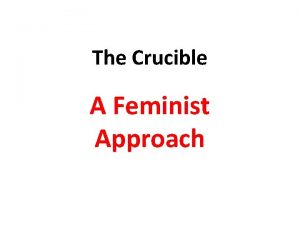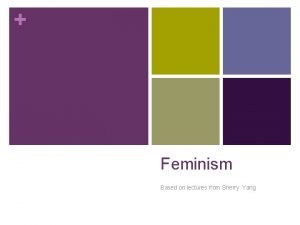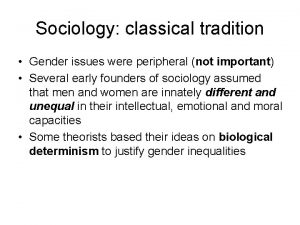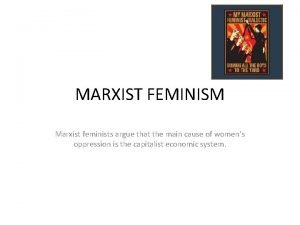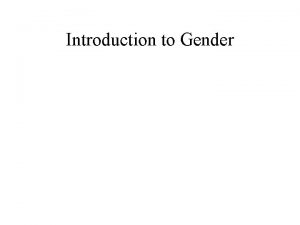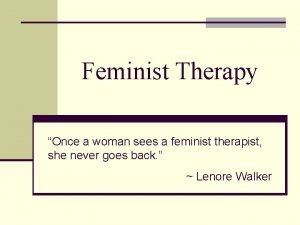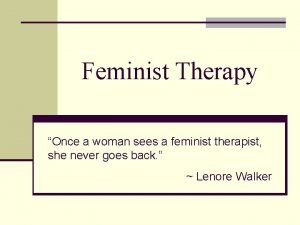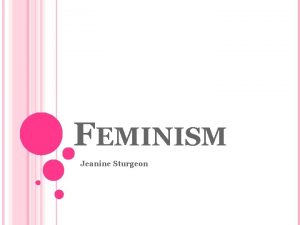FEMINISM Origins Feminism emerged as a twentieth century























- Slides: 23

FEMINISM

Origins � Feminism emerged as a twentieth century movement but has its roots in the nineteenth century in the work of Mary Woolstonecraft, J. S. Mill and others. � � It asserts that society has established problematic power relationships between men and women and that, throughout history, women have been subordinated to men. � � There is a difference between ‘sex’ (which is biological) and ‘gender’ (which is a social construct established in ‘learned’ behaviour thorough socialisation). � The factor which helps to explain such variations is the social construction of gender � Society, therefore, imposes different binary roles, behaviours and expectations on men and women which become reinforced and stereotypical

Introduction cont’d � � � However, there are many types of feminism and therefore it is inaccurate to talk of feminism (in the singular) and more accurate to talk of feminisms (plural). - There are many feminist approaches: Liberal, radical, Marxist, socialist, deconstructionist, Islamic, Choice, Black, postcolonial, even Cyborg… - In fact there are so many different feminism approaches that even Miley Cyrus can call herself a feminist!

Types of Feminism � Key Feminist Approaches � � � 1) What separates different strands of feminism? - If we return to the opening statement ‘Feminism is both a political movement and academic perspective which has its central focus Gender, or more precisely problematic gender relations’ the differences between types of feminism are often categorised by: a. How they understand gender; b. How the problem underpinning unequal gender relationships is defined. � � � � 2) In today’s lecture we are going to discuss some core feminist approaches and relate these approaches back to how gender is understood and how the gender problem is defined. - As such, we will discuss: Liberal Feminism; Radical Feminism; Socialist Feminism; Deconstructionist/Postmodern Feminism

Types of feminism cont’d � � It is these forms of feminism that have marked the main trends in feminist thinking. In case there is any doubt that gender relations are still largely unequal, this very short video helps to illustrate what the world might start to look like if we take men out of the picture � � https: //www. youtube. com/watch? v=GEKo 22 ry Wx. M

Liberal Feminism � � � 1) Liberal feminism argues that the principles related to liberalism are correct (namely the idea of individuals having rights and freedoms) but liberal feminists believe that women have not been included or given access to these rights and freedoms historically - As such, they argue that women should be given access to rights and freedoms on the same basis as men - In the early 20 th century, liberal feminism and liberal feminist activism in Europe and in America revolved around the campaign for suffrage. In other words, women campaigned for civil rights, such as the right to vote. � � � 2) After getting the right to vote, liberal feminism turned its attention to campaigning for other, usually economic, rights – such as equal pay and equal access to employment. - Thus, we could say that liberal feminists seek the same rights as men in a liberal democratic system within the world of work and politics - Feminists refer to this as the ‘public sphere’

Liberal Feminism cont’d � � � 3) In terms of how they understand gender, Liberal feminists believe that gender differences are largely irrelevant in relation to one’s access to the public sphere. - They argue that women have the same intellectual capabilities as men and therefore should be given the same access to individual rights. - As such, these feminists are often referred to as equality feminists – they overlook gender difference and instead seek equality between men and women.

Liberal Feminism (Contd) � � � 1) Liberal feminists define the problem underpinning gender inequality as a problem of representation - Liberal feminists are not suggesting that the current liberal democratic system is wrong – rather they argue that it needs to be corrected by increasing the representation of women - This is why liberal feminists are often referred to as using an ‘add women and stir’ approach 2) The problem according to liberal feminists has been how women have been considered to not be as able as men to conduct themselves within the liberal democratic system – that women were somehow limited - Indeed, this idea that women aren’t as rational as men has quite a long legacy and historically led to women being barred from accessing public life

Liberal Feminism (Contd) � � � - For example, in the 19 C the Victorians (who were obsessed with brain size) spent a long time proving that women’s heads were smaller than men’s heads and therefore women must be too stupid to engage in work and politics - Similarly, it was argued by Victorian physicians that if a woman read too much her womb would shrink and therefore she would be unable to have babies if she did too much reading and thinking. - This clip by the comedian Harry Enfield parodies this position well: http: //www. youtube. com/watch? v=LS 37 SNYjg 8 w - Liberal feminists believe that these ideas of women not being able to compete with men has been the main problem and that this legacy still works against women today - Therefore, liberal feminists believe the solution to this problem is to assist women through anti-discrimination laws to compete on the same basis as men in the liberal democratic system.

Radical Feminism � � � 1) Radical Feminism emerged in the 1960 s and argues that it is not just the lack of women’s participation in public life which is the problem but the very structure of society itself - The political system, and society more generally, has been dominated by men and therefore the odds are stacked against women. If a woman wants to do well, they would argue, she has to behave like a man. � � � 2) The system or structure of society then is considered patriarchal which means that it is dominated by men and therefore works to disadvantage women - This patriarchal system not only plays itself out in the public sphere, in the world of work and politics, but it is also found in the private sphere (also known as the domestic sphere – which relates to the home and the family)

Radical feminism cont’d � � � - In the domestic sphere, institutions of marriage and the family were historically also dominated by men - Men were considered the head of the household – and reduce women to their reproductive roles – in other words, women were oppressed through the expectations on them to make babies and engage in housework - These feminists then were concerned with the subordination of women in the private sphere and the power men had to control female reproduction and sexuality within monogamous marriage (It is important to note that rape within marriage was not criminalised in the UK until 1991)

� � � These inequalities in the private sphere are reflected in women’s relative lack of power and influence in the public sphere - This is why radical feminists coined the term ‘The Personal is Political’ – this refers to the notion that women’s oppression is rooted to male dominance within the home. - Within patriarchal structures, values associated with being a man – assertiveness, competitiveness and aggression – are held in higher esteem than the values associated with being a woman – namely cooperation, expressiveness and a caring disposition - As such, these feminists sought to overthrow patriarchy and the values associated with being a man in order to build a society based on feminine traits like caring and cooperation 4) Radical feminists believe that men and women are essentially different to one another – with men being naturally aggressive, competitive and assertive and women being naturally caring, emotive and cooperative - As such, these feminists are often called ‘difference feminists’ – in other words, they suggest that we are born different.

� � � 5) Radical feminists then define the problem underpinning women’s oppression to be located in the structure of patriarchy - Patriarchy works to devalue feminine traits in favour of masculine ones - However, radical feminists would argue that these feminine traits are just as valuable, or even more valuable, than male traits - As such, some radical feminists proposed the idea of overthrowing patriarchy in favour of a matriarchy - Others suggested that women should live in single sex communities. Often this is referred to as separatist radical feminism or even political lesbianism (rejection of heterosexual, male dominance)

Socialist Feminism � � 1) Socialist feminism also began in earnest during the 1960 s - Like radical feminists they argue that women’s subordination is due to patriarchy, but also that gender inequality is linked to capitalism as well. - Thus, women’s subordination is produced by the social structures and institutions of not just patriarchy but also of a class society. � � � 2) They argue that, capitalism has created a separation between the home, family and personal life on one hand the workplace on the other - For example, the capitalist system requires women to work in the home in order to do two things: Firstly, to look after the home so that men can engage in wage labour; Secondly, to reproduce the next generation of wage workers for the capitalist system - As such, women’s work is essential for capitalism to function

Socialist Feminism (Cont’d) � � 3) However, the work traditionally done by women in a capitalist system, although it is essential for capitalism to function, is considered to be trivial as it is unpaid and is seen as non-productive - In other words, women’s domestic labour is fundamental to the functioning of capitalism but at the same time is not properly recognised within a capitalist system - Also, like the radical feminists, socialist feminists highlight how men tend to control women’s labour and reproduction in the home - Therefore socialist feminists tend to problematize both capitalism and patriarchy (aka patriarchal capitalism)

Socialist Feminism (Contd) � � � � 4) In terms of understanding gender, Socialist Feminists recognise unequal gender relations to be a by-product of the system of patriarchal capitalism - The structures of patriarchal capitalism benefit from promoting ideas that women are naturally programmed to like housework and childcare - They think the idea that men and women are suited to different roles is an ideology which promotes the dominance of men and the middle classes - As such, they see gender to not be something we are born with naturally (like our biological sex) but rather as ways of behaving which we are socialised into - And it is this socialisation (through toys, norms, dress codes etc) which has led to women being considered suitable for home-life and men for wage work

Socialist Feminism (Contd) � � � 5) For socialist feminists gender inequality is therefore a consequence of patriarchal capitalism - As such, both patriarchy and capitalism need to be overthrown and replaced with a system whereby men and women are not associated with different forms of labour - Thus, for eg, Socialist Feminists felt that housework should be shared between members of the household equally - They also recommended the redesign of homes in ways that would maximize the potential for creativity for both men and women - For example, emphasizing the need for rooms like studios and studies, getting rid of the kitchen and dining room and thus moving food preparation and eating into a more communal setting

Deconstructionist Feminists � � 1) Deconstructionist feminists (aka 3 rd wave feminists) emerged in the 1990 s - This contemporary form of feminism understands the labelling or categorising of our bodies as either male of female is the root of gender inequalities - For eg, when someone has a baby the most culturally important question is ‘is it a boy or a girl? ’ and the idea that the baby can remain an ‘it’ – with no gender specification – is considered to be an impossibility � � � This ‘gendering’ is a culturally embedded practice - In other words gender ambiguity is excluded, and we are allocated a sex or a gender identity from birth

Deconstructionist Feminists (Cont’d) � � � - Even babies born with ambiguous genitalia are usually surgically altered so that they can fit into this labelling system - This labelling system is in itself somewhat arbitrary and is a way of perpetuating inequality as the attributes which are linked to femininity are considered inferior to those which are linked to masculinity - They believe that the consequences of allocating a body a sex based on the shape of its genitalia, which after all makes up less than 1% of our bodies, and then suggesting that those bodies which are sexed as male will behave in a particular way (for example being good at map reading) and those bodies that are sexed as girls will behave in the opposite way is hugely problematic

Deconstructionist Feminism (Contd) � � � � 3) In terms of understanding gender, deconstructionist feminists suggest that sex as well as gender are produced through discourses – they are discursively constructed - Thus, gender is created through our use of language which is structured to label bodies as male or female, masculine or feminine - Once the labelling has taken place, once you have been named either boy or girl – then you play out or perform the roles which are seen as appropriate for males and females - By repeating these appropriate behaviours, gender appears as though it comes naturally – however, these are behaviours which you learn to do rather than ones which you have been born to do - ‘Gender is the repeated stylisation of the body, a set of repeated acts within a highly rigid regulatory frame that congeal over time to produce the appearance of substance, of a natural sort of being’ (Judith Butler, 1990, Gender Trouble, p. 33)

Deconstructionist Feminism (Contd) � � 4) Thus, the ‘problem’ for deconstructionist feminists is this labelling process - As such, they aim to deconstruct the language system relating to masculinity and femininity to demonstrate how these categories are not biologically real categories but rather part of our language system - This can free both men and women from behaving in the ways that we are expected to behave (for eg, without the labelling men would no longer be expected to have to be the first person who goes down stairs to confront potential intruders in the house!) - In other words, if we dismantle the language of gender – we also dismantle the expectations which are attached to our gender roles – and would therefore be more free to engage in a wider range of behaviours

Type of Feminist Liberal Feminist Radical Feminists Socialist Feminists Deconstructionist Feminism How do they understand gender? What is the problem underpinning gender inequality? Gender is irrelevant as men Women’s lack of access to and women have the same politics and wage work capabilities. within a liberal democratic system Gender differences are The system of patriarchy natural differences and the attributes linked to femininity should be given equal or higher esteem to those attributes related to masculinity. Gender is a behaviour which The system of patriarchal is not natural but which we capitalism are socialised into in order for patriarchal capitalism to work. Both sex and gender are The value placed on bodies discursively constructed. labelled as male or female; masculine or feminine

Conclusion � � Most would agree that equality is a good thing. But there are many strands to feminism. Asking someone ‘are you a feminist? ’ is a flawed question. The question should be: ‘What kind of feminist are you? ’
 Parker v 20th century fox
Parker v 20th century fox Parker v twentieth century fox
Parker v twentieth century fox Twentieth sunday after trinity
Twentieth sunday after trinity How did parliament emerged victorious in medieval england
How did parliament emerged victorious in medieval england Who emerged as patrons in the baroque period?
Who emerged as patrons in the baroque period? Urdu hindi controversy
Urdu hindi controversy 4 waves of feminism
4 waves of feminism Objectives of feminism
Objectives of feminism What is post feminism
What is post feminism The crucible feminist lens
The crucible feminist lens What is feminism
What is feminism Radical feminism slideshare
Radical feminism slideshare Marxist feminism theory
Marxist feminism theory Snow white theories
Snow white theories Marxist feminism example
Marxist feminism example Feminism
Feminism Feminism literary approach
Feminism literary approach Literary approaches structuralism/formalism
Literary approaches structuralism/formalism Cultural feminism example
Cultural feminism example Marxism and feminism similarities
Marxism and feminism similarities Postmodern feminism
Postmodern feminism Feminist therapy
Feminist therapy The story of an hour literary devices
The story of an hour literary devices Feminism in the secret life of bees
Feminism in the secret life of bees









